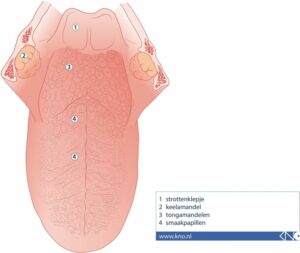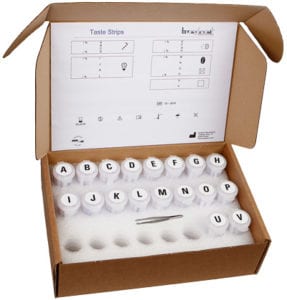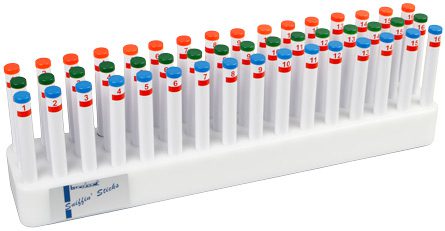
Taste, how does it actually work? Taste is the way our brain perceives the stimuli from taste buds. Of course we all know the five flavors; sweet, bitter, salty, sour and umami. But how do you describe the taste of mint, for example? Of course, the five basic tastes do not give the full picture of what we experience when we eat or drink. Beyond these five areas there is a whole area of sensation available to us; this realm is what we call taste and much of this comes from our sense of smell.
What flavors are there?
There are 5 different flavors, these are:
- bitter
- sweet
- salt
- sour
- umami
What is umami?
In addition to the well-known flavors sweet, sour, salty and bitter, umami has been recognized as the 5th taste for over 100 years. Umami is a Japanese word that translates as ‘pleasant, savory taste’. While chewing, after about 20 to 30 seconds you will experience a different taste than the previously heard sweet and sour; somewhat savory. That’s umami. Umami is present in a wide variety of foods. Anything containing glutamates, including many fermented and aged foods. Some examples are; soy sauce, cheddar, mushrooms and red meat.
Sense of taste and the tongue map (taste map)

The tongue map shows which parts of your tongue receive certain flavors. The tongue is divided into regions, each responsible for detecting a particular taste. If we look at these regions, there are 3 different types of taste buds. The papillae circumvallatae on the back of the tongue, the papillae foliatae on the back of the tongue and the papillae fungiformis and filiformis spread on top of the tongue.
In previous studies it was thought that each taste was perceived in a different place on the tongue, but that is not correct. We experience stronger bitter flavors more towards the back of the mouth and sweet flavors towards the front, so there is a spatial location of taste. Taste transmission from the posterior part of the tongue runs via the glossopharyngeal nerve, the anterior two-thirds via the chorda tympani.
What taste disorders are there?
We can distinguish the following taste disorders:
- ageusia: complete absence of taste (quantitative taste disorder)
- hypogeusia: there is a reduced sense of taste (quantitative taste disorder)
- hypogeusia: the sense of taste is stronger than usual (quantitative taste disorder)
- parageusia: flavors are perceived in a different way, or a misinterpretation of the taste. In many cases, normal tastes are perceived as unpleasant tastes, this is known as dysgeusia (qualitative disorder)
- phantogeusia: the perception of tastes without a stimulus (qualitative disorder)
A taste disorder can manifest itself in different ways. There may be a decreased or disappeared taste function. Everyday flavors can also be perceived differently or there is a continuous abnormal or bad taste sensation, without a flavoring substance being ingested. For many flavor components, such as chocolate, coffee and strawberry, the primary component is an olfactory perception. Chewing releases odorants that reach the olfactory organ when exhaled through the nasopharynx. The complaint of “impaired taste” should always be associated with an olfactory disorder.
General advice for taste disorders
- Maintain good oral hygiene.
- Ensure sufficient food intake, loss of taste can reduce appetite.
- Beware of overconsumption of sugars and salt.
- Adjusting nutrition to improve the entire taste experience:
- accentuating the structure, temperature, spiciness and spiciness of the food;
- try carbonated drinks with an emphasis on sweet, sour and bitter, such as bitterlemon;
- use of flavor enhancers, such as monosodium glutamate (Ve-tsin, E621);
- when the sense of smell is intact: alternating aromas in food.
Connection between taste and smell
Smell and taste, most people are aware that taste and smell are closely linked. Indeed, much of the overall flavor of food and drink is the result of the olfactory neurons at the top of our nasal cavity detecting molecules from the food we eat. How does this happen? We detect the smell of food in front of us when its molecules enter our nostrils, but most of the flavors we perceive come from the mouth itself. This is done through a process called retro nasal olfaction.
Retro nasal olfaction is the journey that the molecules of what we eat take. This passes through the nasal cavity to the passage that connects it to the back of our throat. This is also why wine tasters hold wine in their mouths and swish it around before spitting it out. In this way they stimulate as much flavor as possible in the nose to get a better feeling of the bouquet of the wine.
Taste loss
What does this mean for you if you suffer from loss of smell? Having loss of smell has a major effect on your taste and ability to enjoy food. Depending on the degree of odor loss you experience, much, if not all, of the flavor of food can be lost. As a result, the appetite no longer works in the same way. If you can’t smell dinner in the oven, how can you look forward to eating it and what stimulates the body to prepare for dinner? Normally, salivation occurs in response to food-related odors. When you suffer from loss of smell you have to trust your body to tell you it’s time to eat, but this doesn’t always work. As a result, you may simply forget to eat and run the risk of weight loss or malnutrition.
Taste training?
In case of loss of smell, we recommend smell training. Smelling odors daily ensures that the recovery of the sense of smell is stimulated. Unfortunately, there is nothing comparable for training the sense of taste. As mentioned earlier on this page, changes in the sense of taste often occur in combination with loss of smell. This may involve the following changes:
- Loss of taste (you no longer taste the basic flavors: sweet, salty, sour, bitter, umami)
- Taste distortions (tastes are perceived differently, often nasty)
Loss of taste is less common than loss of smell. Do you still taste the basic flavors salt, sweet, bitter and umami on your tongue? Then you are most likely dealing with a loss of smell and not a loss of taste. Loss of taste is probably caused by the virus being in the saliva, which affects taste transmission. It is not (yet) entirely clear how this works exactly.
Taste tests
We offer various test kits in the field of taste testing. In our webshop you can find an overview of the available taste tests. Burghart’s taste tests are known as the ODOFIN taste strips and are available in a complete kit containing the tastes sweet, sour, bitter and salt in 4 different concentrations. This set can possibly be expanded with the 5th taste umami. The taste strips are also available as a basic set of 4 tastes in the highest concentration.
Another option are the taste strips from Sensonics, such as the WETT taste test with the basic tastes, but also the PROP and PTC strips that can be used to identify supertasters.
Do you have any questions about our taste tests? Please let us know via our contact form or info@medi-sense.nl










